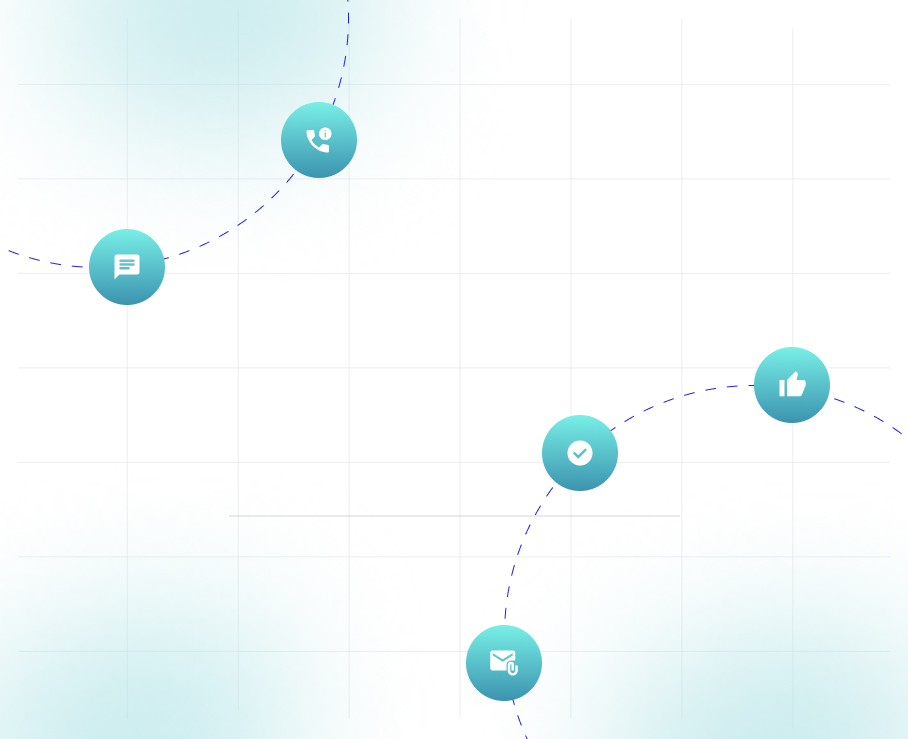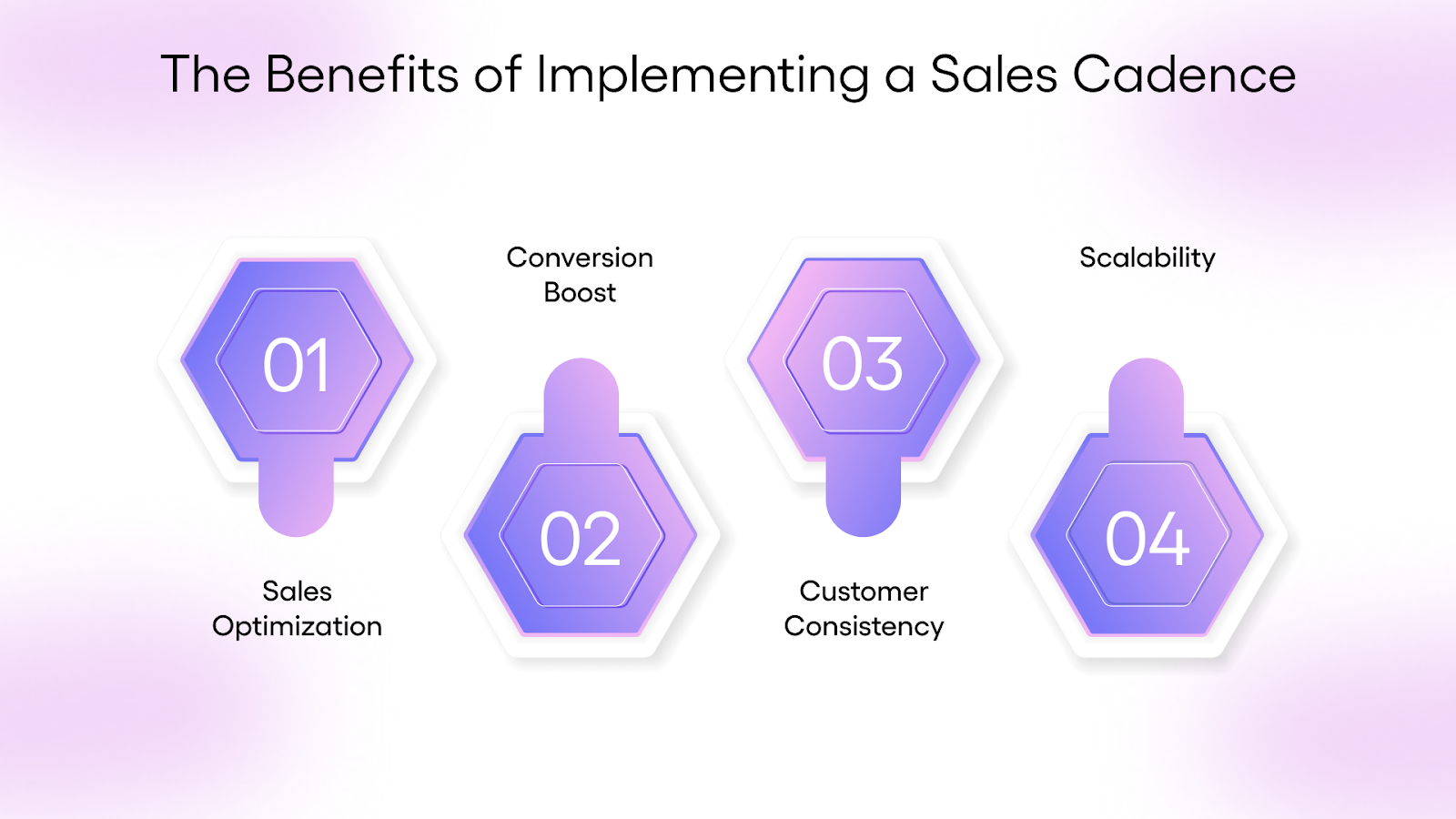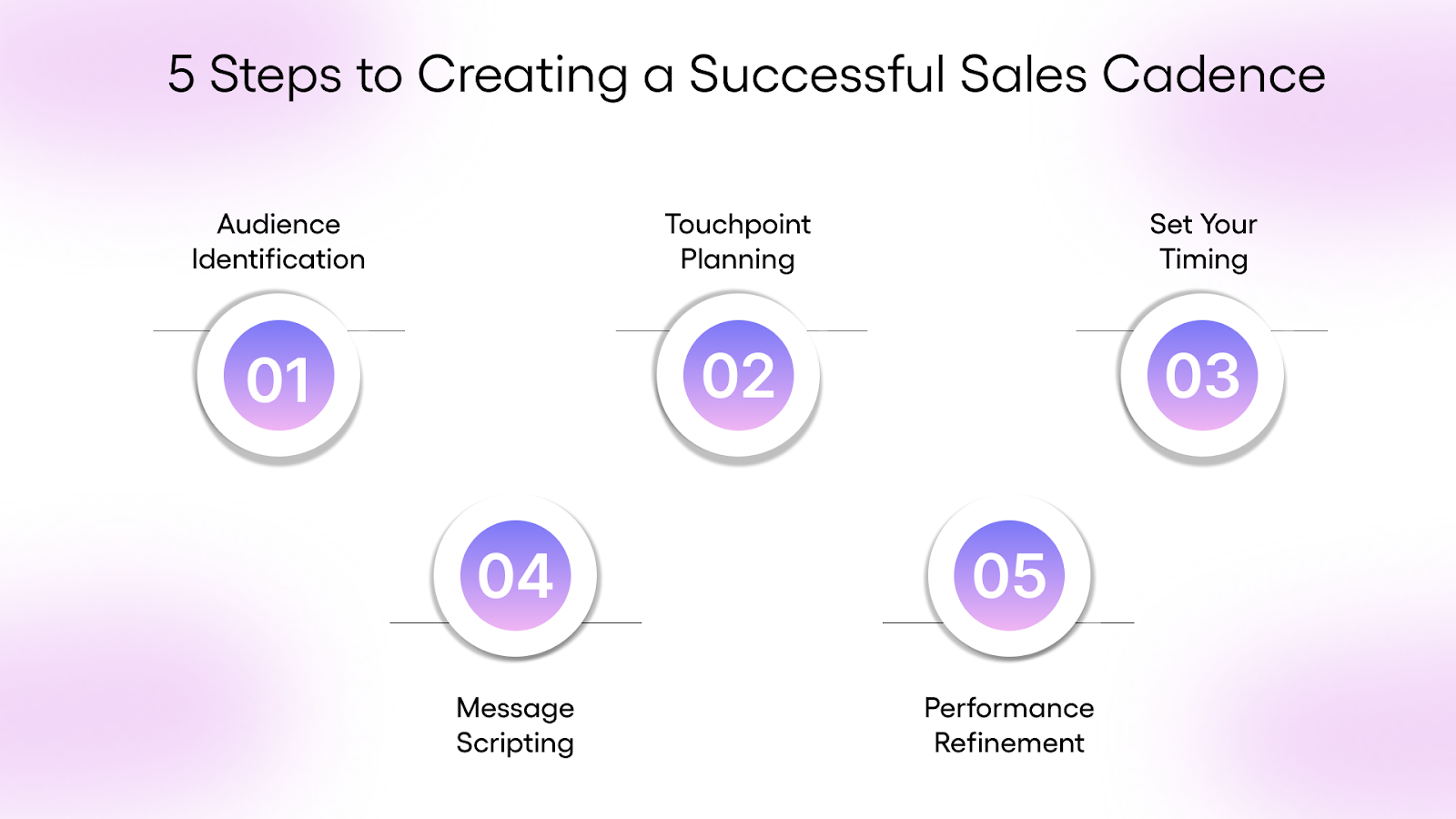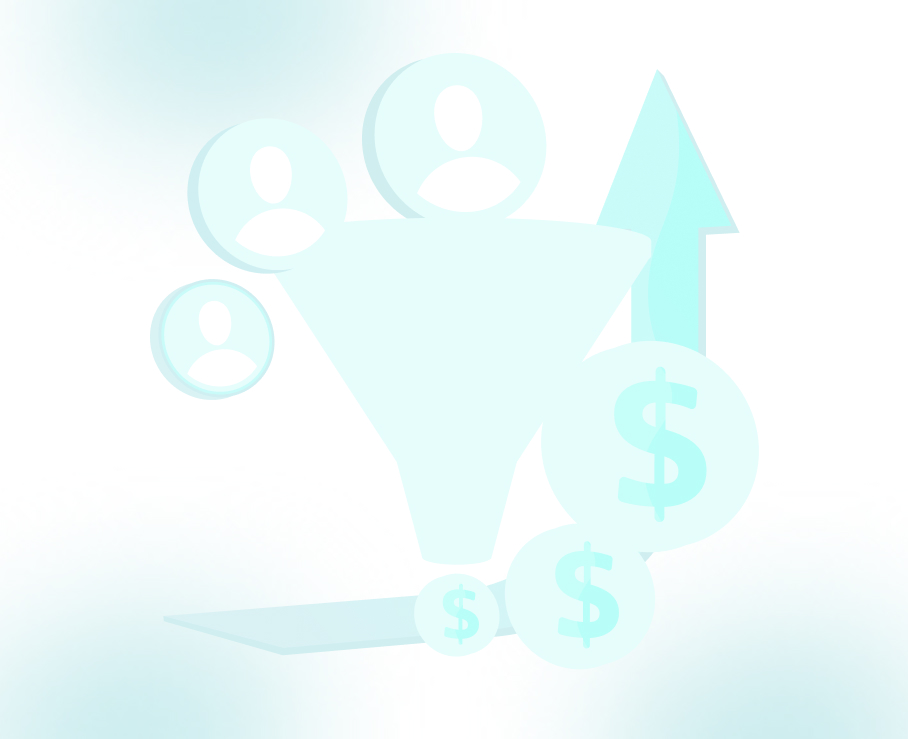
How to Build an Effective Sales Cadence: Tips and Examples

If you’re in sales, you’ve likely faced the frustration of leads not responding, despite sending the right message at the right time. But outreach alone isn’t enough. What matters is how organized, timely, and relevant your follow-ups are.
With today’s lead-gen services and email platforms, sales teams have more ways to connect, but so does everyone else. Cutting through the noise takes more than effort; it takes strategy.
That’s where a strong sales cadence comes in. It’s not just a schedule of emails and calls; it’s a structured plan that defines when, how, and why you engage, ensuring every touchpoint moves prospects closer to a decision.
In this blog, we’ll break down what a sales cadence is, why it matters, and how to build one that actually converts. Plus, we’ll share real-world examples to guide your approach.
What is a Sales Cadence?
A sales cadence is simply a sequence of sales activities and touchpoints that your sales team follows to engage with a lead or prospect over a set period. These touchpoints can include a variety of methods like emails, phone calls, social media outreach, direct mail, and even in-person meetings.
Imagine a scenario where a prospect fills out a form on your website. Your sales cadence will determine the steps that follow, including how soon you should reach out to them, which channels you should use, and how often to follow up.
A well-structured sales cadence serves as a roadmap for your sales team, making the outreach process more efficient, predictable, and measurable. Whether it's a quick transactional sale or a longer, more complex sales cycle, the cadence you choose can make a huge difference in how successfully you engage your leads.
The Benefits of Implementing a Sales Cadence

Sales cadences are not just about being organized, they are about maximizing the effectiveness of every touchpoint. It ensures your outreach consistently delivers value to your prospects. Let's take a look at the key benefits that come with a well-implemented cadence:
1. Increased Sales Efficiency
Sales teams have a lot to juggle: prospects, meetings, calls, and emails. In fact, only 53% of sales professionals spend most of their day selling. This means a lot of time is spent figuring out what to do next rather than focusing on actual sales activities.
With a predefined cadence, sales reps don't waste time deciding when or how to follow up with prospects. By following a set schedule, they know exactly what to do and when to do it, allowing them to focus on building relationships and closing deals rather than managing the logistics of outreach.
2. Improved Conversion Rates
Statistics show that even top-performing sales reps need around five touchpoints to successfully convert a prospect. Your potential customers face many distractions, and your product or service isn’t always top of mind. A strong sales cadence ensures that you stay on their radar and engage them at the right times.
Without a clear cadence, follow-ups can be inconsistent, and opportunities may slip through the cracks. But with a defined sequence, your team can ensure that no lead is left behind, and every prospect gets timely attention.
3. Consistent Customer Experience
Prospects are more likely to engage with salespeople they trust, and trust is built through consistency. When your sales team follows the same structured process, it ensures every lead gets the same level of attention and care, regardless of who’s reaching out.
A consistent cadence also makes it easier to track the success of your outreach efforts. You can monitor the effectiveness of each touchpoint and adjust your approach based on what works best. This gives you valuable data to refine your sales process over time.
4. Scalability
As your business grows and you start attracting more leads, you need a system in place to manage them. A scalable sales cadence allows you to maintain high-quality engagement with a larger volume of prospects without sacrificing the personal touch.
A well-defined cadence is also a great tool for onboarding new sales reps. Instead of leaving them to figure out the best way to engage leads, they can follow a proven process that has already been optimized for success.
5 Steps to Creating a Successful Sales Cadence

Now that you know why a sales cadence is crucial, let’s look into how to create one. Here’s a step-by-step guide to building a sales cadence that works for your business:
1. Identify Your Target Audience
Before you can design a sales cadence, you need to understand who you're reaching out to. Is your ideal customer the CEO of a large corporation, a manager at a medium-sized business, or an owner of a small startup? Understanding your target audience will help you choose the right communication methods and tone.
Develop a buyer persona that includes:
- Their position in the company
- Responsibilities and challenges
- Company size
- Pain points and objectives
- Preferred communication channels
The more you know about your prospects, the easier it will be to create a cadence that resonates with them.
2. Decide on Your Sequence of Touchpoints
Once you’ve identified your prospect, it’s time to plan how you’ll engage with them, starting with email. Email is still one of the most effective ways to reach out: it’s non-intrusive, easy to personalize, and ideal for delivering value right away. Depending on the nature of the lead, you can optionally add a LinkedIn touchpoint or a quick call, especially if there’s been prior engagement or it’s a high-value prospect.
The key is staying consistent without overwhelming. A thoughtful sequence increases your chances of getting a response while keeping the communication natural and relevant.
Read: Why Email Marketing Is a More Effective Strategy Than Cold Calling
3. Set Your Timing
One of the biggest challenges in sales cadences is determining the right intervals between touchpoints. If you follow up too soon, you risk annoying the prospect. If you wait too long, you might lose their interest.
For example, the most effective sales cadences often begin with more frequent touchpoints, such as three or four interactions within the first week. As the process continues, you can space them out to keep the prospect engaged without being too pushy.
Research suggests that six touches spread out over three weeks often yield the best results for email campaigns. Test different intervals to see what works best for your audience.
Read: The Best Time to Send Marketing Emails in 2025
4. Script Your Messaging
Consistency is key to a successful sales cadence, which means your messaging should be standardized for each touchpoint. While each message should be tailored to the stage of the sales process, it should follow a clear and consistent structure.
For example:
- The first email introduces your company and offers a solution to the prospect’s pain points.
- The second call dives deeper into the benefits of your product or service.
- A follow-up email could share a case study or more detailed information about your solution.
Having a set script ensures that every rep delivers the same message, maintaining consistency and professionalism.
5. Test, Monitor, and Optimize
Building a sales cadence isn’t a one-and-done task. Once you’ve implemented your cadence, it's important to monitor its performance and make adjustments as needed. Track metrics such as:
- Engagement rates
- Conversion rates (how many leads turn into customers)
- Churn rates (how many leads drop off after each touchpoint)
- Sales cycle length (how long it takes to close a deal)
- Customer acquisition cost (CAC)
This data helps you refine your cadence and adapt it to what works best for your team and prospects.
Best Practices to Follow in Sales Cadence

An effective sales cadence isn’t just a checklist of emails or calls, it’s a system for managing outreach with purpose, clarity, and consistency. Whether you’re nurturing inbound leads or reaching out cold, the right cadence helps you stay relevant without being repetitive.
Here are key best practices to build a high-performing sales cadence:
1. Start With a Clear Objective
Before building your cadence, define the single action you want the prospect to take, whether it's booking a meeting, attending a demo, or responding to your email. Without this clarity, your messaging can drift and your sequence can lose impact.
Pro Tip: Make sure every touchpoint supports that objective. Mixed CTAs confuse prospects and reduce engagement.
2. Build a Purpose-Driven Sequence
Sales cadence isn’t about throwing in emails and calls—it’s about designing a logical, progressive flow. Each step should have a clear purpose: introducing, educating, reinforcing, or prompting action.
Example Flow:
- Touch 1: Introductory email
- Touch 2: Follow-up with a useful resource
- Touch 3: Soft engagement (e.g., LinkedIn like or comment)
- Touch 4: Reminder or question-based email
- Touch 5: Light call (only if warranted)
- Touch 6: Final nudge or breakup email
Keep the pacing natural, front-load slightly, then space out. Six to eight touches over two to three weeks is a solid benchmark.
3. Make Every Message Count
Each interaction should build on the last, not repeat it. Think of your cadence as a story unfolding. Start by establishing relevance, then address pain points, and end with a strong, action-oriented close.
Avoid: Sending multiple variations of “just checking in.”
Instead: Layer in new angles, case studies, questions, trends, or social proof.
4. Personalize With Intent
Even a templated cadence can feel personal when tailored thoughtfully. Go beyond “Hi {FirstName}”—reference their industry, role-specific challenges, or recent updates.
High-impact ways to personalize:
- Mention a specific pain point tied to their job
- Reference a recent company announcement
- Use language aligned with their function (e.g., ROI for finance, efficiency for ops)
5. Stay Structured, But Adapt When Needed
A sales cadence should give you structure, but not at the cost of common sense. If a prospect responds early, drop the rest of the sequence and pivot to real-time engagement. If someone goes cold, don’t blindly finish the sequence—adjust tone, timing, or channel.
Build in exit points for when a lead engages, and review disengaged leads before restarting another round.
6. Monitor, Measure, and Iterate
No cadence is perfect from day one. Track performance metrics to understand where leads drop off or convert, and refine your approach accordingly.
Key metrics to track:
- Reply rate per step
- Meeting conversion rate
- Touchpoint drop-off trends
- Average time to response
Treat your cadence like a living strategy; what works today might need adjusting next quarter.
A winning sales cadence isn’t about doing more, but doing it with purpose. When each step is intentional, personalized, and aligned with your goal, you create a rhythm that builds trust and drives action, without overwhelming your prospects.
Want to See Sales Cadence in Action? Here's Proof.
A West Chester, Ohio-based MSP recently closed a $9,000/month deal with a fast-growing design firm. Before partnering with TLM, they struggled with cold calls, purchased lists, and low-performing email blasts. Despite investing heavily in their MSP business, quality leads just weren’t coming in, and their burn rate was rising fast.
That changed when they brought in TLM. Within just three months, our team:
- Built verified, high-intent prospect lists using in-house scraping.
- Launched strategic email cadences focused on pain points and conversion
- Scheduled warm and hot leads directly into the client's calendar
The result? 95% of their clients now come from TLM-generated leads. Their $10–12K annual spend with us has delivered 50x ROI, and with TLM in their marketing mix, they’ve begun acquiring other MSPs to scale confidently.
How TLM Enhances B2B Lead Generation with Effective Sales Cadence
At TLM, we don’t just build sales cadences, we help you transform them into real, revenue-generating systems. Our approach combines precision prospecting, smart segmentation, and email-first strategies that are personalized, relevant, and conversion-focused. We take the heavy lifting off your plate by identifying the right contacts, crafting tailored messages, and delivering them at the right intervals, so your outreach feels more like a conversation and less like a campaign.
For high-value accounts, we incorporate account-based marketing strategies that speak directly to decision-makers, cutting through the noise with highly contextual outreach. And with built-in appointment scheduling and data-driven optimization, we make sure your sales team spends less time chasing cold leads and more time closing warm ones.
Whether you're struggling with unresponsive leads, inconsistent follow-ups, or lackluster conversions, TLM gives your sales cadence the structure and substance it needs to perform. We bring in our proprietary tools, experience, and insight to turn every email into an opportunity, and every opportunity into results.






